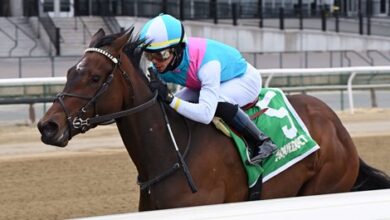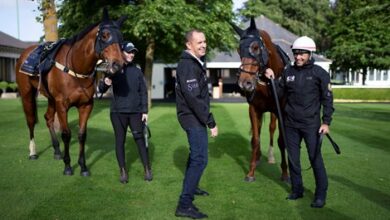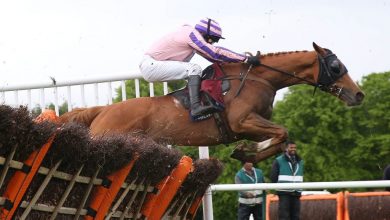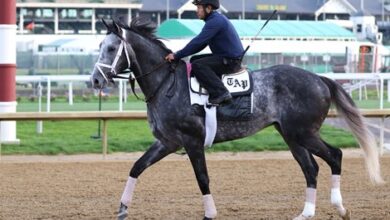Raindrops Keep Falling on NYRA’s Track Maintenance Team
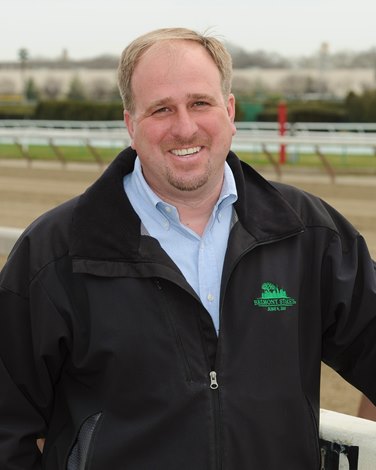
The past three months have been as exasperating as life can get for Glen Kozak.
The New York Racing Association’s executive vice president of operations and capital projects has faced rainy seasons before in 33 years of work in the field of track maintenance.
But when you take enough rain to cause Noah to start pairing animals and add in a spate of horrific breakdowns at Saratoga Race Course plus the massive assignment of renovating Belmont Park‘s surfaces and laying the groundwork for a new facility, the task facing Kozak and his crew can be daunting, to say the least.
“We have felt pressure on a lot of fronts, not just the weather,” Kozak said. “There’s an awful lot to deal with.”
There was heavy rainfall since Saratoga opened July 13 and it increased to staggering proportions since the Belmont at the Big A meet began Sept. 14 at Aqueduct Racetrack. While there was nearly 12 inches of rain at Saratoga through Labor Day, from Sept. 4 until Oct. 15 Aqueduct has been soaked with 16.68 inches of precipitation.
That’s more than two feet of rain—and it rained Oct. 20 causing a sloppy track at the Big A with forecasts calling for more rain Oct. 21, which would make it the seventh straight weekend with rain on a Saturday or Sunday and the 11th Saturday of racing out of the last 14 without fast and firm track conditions.
The forecast for Saturday was so gloomy early in the week that the NYRA racing offices scrapped all of its turf races in the condition book and carded a dirt-only program with the Athenia Stakes (G3T) on turf moved to Oct. 27.
“It’s a Saturday,” Kozak said. “What else do you expect but rain?”
It’s a situation that can be overwhelming for a circuit with surfaces at three different racetracks to maintain, but on the positive side NYRA has given Kozak the resources to build a dream team to work for him. Kozak’s highly experienced staff of about 45 includes key leaders such as senior director of track operations Brian Jabelmann, turf superintendent Robbie Mitten, and dirt superintendent David Whitman.
New to the mix is Leif Dickinson, a highly respected expert on turf courses, who will focus on the construction of two turf courses at the renovated Belmont Park as NYRA’s senior director of turf and grounds.
“It’s great to bring in staff that is very competent and add to what we have. We have guys who have been doing this for 30, 40 years and are very well respected. It helps to have guys with the same mindset and focus. They complement each other. When you can bring in Leif with his experience, that’s great. And even though he has dealt mostly with warmer weather, when you also have someone like Robbie who has been dealing with East Coast tracks and is one of the best in the business, it’s great for NYRA,” Kozak said. “We have an awful lot on our plate with three tracks and the renovation at Belmont plus adding the synthetic track at Belmont and putting in two new turf courses there. It’s sometimes a very, very difficult job to handle with the weather, the personalities, the pressures, and we’re fortunate that we get management and board support to move these projects forward.”
For all of the wet dirt tracks the persistent rain has produced, Mother Nature’s wrath has been felt most on the turf courses at Saratoga and Aqueduct. At the Big A alone, seven turf stakes have been shifted and three cards have been canceled.
At Saratoga, 21 of the 40 days saw at least one race come off the turf and from Aug. 4-31 there were 16 of 20 days with one or more moved off the turf course.
“Every time we take one step forward, we get knocked back two steps,” Jabelmann said.
Beyond that, since Saratoga opened there was just one week when there were no races taken off the turf (the Sept. 14-17 start of the Belmont at the Big A meet).
“The rain hit us hard, especially the timing of it. We kept getting nailed during racing. In the summer it seemed like every time we got the track dried out, it rained. The track was good in the morning for training and then rain would come in a half-hour before the first turf race. We felt like whenever we put a starting gate on the turf, it was a lightning rod for rain,” Kozak said. “Some days we would get forecasts calling for three inches of rain throughout the day and we’d get four in two hours.”

The NYRA track maintenance crew seals the main track at Saratoga Race Course
Mindful of what Kozak and his crew has faced, key participants have voiced praise for the team’s work.
“(The maintenance crew) has worked tirelessly for several months now trying to keep the surfaces together. All told. It’s an amazing job they have done,” said Joe Appelbaum, president of the New York Thoroughbred Horsemen’s Association. “It’s an unprecedented situation and we have a good crew that is trying it’s best.”
NYRA’s jockey colony also spoke in unison about how they believed the surfaces at Saratoga were safe throughout a meet plagued by seven injury-related fatalities during races.
Rain Forces Stakes to be Pushed Back a Week
The soggy weather pattern also caused NYRA to reassess how it deals with turf stakes during New York’s answer to monsoon season. In the past, those added money grass events were simply moved to the main track with a handful of starters.
But beginning with the National Museum of Racing and Hall of Fame Stakes (G2T) at Saratoga, which was moved from Aug. 4 to the Aug. 11, NYRA has been canceling selected turf stakes and moving them to the following week in hopes of finding a dry surface.
Included in that group of stakes was the Joe Hirsch Turf Classic Stakes (G1T), which was pushed back a week.
Originally scheduled for Sept. 30, the Joe Hirsch was moved to Oct. 7 when 8.5 inches of rain on Sept. 29 prompted NYRA to move the entire Saturday, Sept. 30, card to Oct. 1 and push the Sunday, Oct. 1, card to Oct. 4, which had been a dark day.
“Management has certainly been proactive with monitoring the weather and if we can adjust the scheduling of races we will,” Kozak said. “We have had to shift or transition our model of how to handle things because we have so many turf races now.”
Saratoga was an extremely difficult time with those seven injury-related equine fatalities, and in preliminary findings New York State equine medical director Dr. Scott Palmer said “unprecedented amount of rainfall” was a “significant factor” in the fatalities.
Kozak said he and his team were “sick to their stomachs” about the fatalities and hoped some meaningful data can be gleaned to address the situation.
“Hopefully there will be something good to come out of a bad situation to make it better,” Kozak said. “What Dr. Palmer has been able to recognize with the moisture content is that there’s a limited amount of stuff we can do on the track to modify the racing condition of the dirt track.”
Tapeta Surface to be Included at Belmont
One means toward a safer racing surface is through a synthetic racetrack and a key part of the new Belmont Park will be a one-mile Tapeta all-weather surface. Synthetic surfaces are also being discussed for Saratoga and possibly Aqueduct.
“What is eye-opening about the synthetic tracks is that even with the Tapeta pony track at Belmont with 10 inches of rain it was fast,” Kozak said.

Glen Kozak takes a call on the apron adjacent to the main track at Saratoga Race Course
Jabelmann, who has been involved with track maintenance for more than 40 years, worked at Woodbine when a synthetic surface was added.
“It has a lot of promise, especially with weather like this,” Jabelmann said about the synthetic surface. “It’s benign to the weather and rain affects it to only a small degree. It’s the future of racing. I think once trainers get used to it they will really love it. It’s better for racing, for the company and for the horses. It’s a stable footing.”
While dealing with the day-to-day issues of today’s racing, Kozak and his crew are also working toward the construction of a rejuvenated Belmont Park with a modern grandstand and new dirt, turf, and Tapeta racing surfaces.

Construction in the Belmont Park infield
In all likelihood, racing will not resume at Belmont Park until 2026 or 2027 and work is underway now, with construction of the Tapeta course, and the building of three tunnels to the infield (with one completed) and a pond with a pump station for irrigation.
Besides a backstretch tunnel that is in place, two frontside tunnels will be built near the clubhouse gap to the racetrack for horses and the sixteenth pole for pedestrians. Work has already started on the clubhouse tunnel and construction of the grandstand tunnel is expected to start in mid-November.
Dickinson to Focus on Turf Courses
Dickinson, whose most recent job involved “rejuvenating” the Gulfstream Park turf course, has also worked at Del Mar, Santa Anita Park, Golden Gate Fields, and Hollywood Park and is considered a foremost expert in dealing with turf courses.
He said his goal is to make the two rebuilt Belmont turf courses the envy of the industry.
“I want those turf courses to be the best in North America, and maybe the world,” Dickinson said. “The opportunity to build not just one but two turf tracks from the bottom up does not come around these days. There’s not a lot of new things happening in racing. It’s challenging to make sure that the track is strong and set up for racing and can handle a lot of races. With turf courses you have to get them right from day one. You can’t change it like you can a dirt track. It is what it is. That’s the challenge. It’s not about how it looks, but how it performs.”
